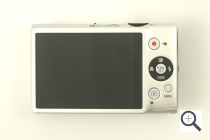Spring is definitely here (at least in the Ohio River Valley) and there is no better time to test a new camera than during the
prettiest of the four seasons. The new Canon PowerShot ELPH 110 HS replaces last year's very popular 300 HS compact. On the surface, the two cameras don't appear to be much different, but Canon has made a few interesting and useful changes under the hood. The most significant difference between the two cameras is the dramatic leap in resolution - from 12 megapixels (300 HS) to 16 megapixels (110 HS) otherwise the 110 HS is a relatively straightforward, mostly cosmetic, update of one of Canon's most popular shirt pocket digicams. The 110 HS has a decent assortment of the latest bells and whistles and features a full complement of consumer-tested hardware.
The 110 HS's 5x f/2.7-5.9 optical zoom provides a (35mm equivalent) range of 24-120mm and is the same wide-angle to a short telephoto optic that graced its predecessor. The 110 HS's large 3.0-inch LCD dominates the back of this tiny camera and boasts 461k-dot resolution, which is more than adequate for a camera in this class and twice the resolution of earlier generations of ELPH LCDs.
The 110 HS also includes a slightly improved version of the same Intelligent IS image stabilization system first seen on the 300 HS, which provides six distinct IS modes to cover different shooting scenarios like handheld macro shots, panning to follow the action as it unfolds, and shooting with the camera mounted on a tripod. Improvements seem to be limited mostly to the greater range of correction when shooting video. The 110 HS's sensitivity ranges from ISO 100 to a maximum of ISO 3200, unchanged from the 300 HS and the 110 HS's dependable and very accurate white balance system is identical to the one used in the 300 HS, as well.

Changes include a new face recognition mode called "face ID" which permits the camera to remember up to twelve specific people with up to five different facial shots saved in-camera for each selected subject. Once the function is programmed the shooter can enter the name and birth date of his or her friend/loved one and the 110 HS will automatically lock focus on that individual in a group shot. The face ID function can also be programmed to prioritize focus on one of three age groups - baby/infant, child, or adult.
If all that isn't enough the 110 HS's Smart Auto mode (which is actually an automatic scene recognition mode) now features 58 distinct scene types. Here's an example (from Canon) although I didn't get an opportunity to try it - if you want to shoot cute pictures of your sleeping baby, the 110 HS will automatically determine that the baby is sleeping, optimize facial focus, disable the flash and the AF assist lamp, optimize exposure, sensitivity, and WB for the ambient lighting, and turn off all camera sounds to avoid waking the slumbering infant. Absolutely perfect for capturing those "brag" shots to post on Facebook or send to the doting grandparents.
Digital cameras today must not only be competent still picture takers, they must also be competent video cameras.
Canon didn't drop the ball on this one - the 110 HS may be small in stature, but it doesn't skimp on large scale usability. Like its predecessor, the 110 HS can record at up to Full HD (1920 x 1080p at 24fps) resolution with stereo audio and the capability to use the 5x optical zoom during video capture.
In addition, for those who want to document their photographic adventures, the 110 HS features an upgraded version of Canon's nifty Movie Digest function, which automatically saves a short video clip (up to four seconds) from just before the shooter snaps each picture. The 110 HS automatically combines those short clips to create a sequential video record of the days shooting. Movie digest files are limited to 720p, but that is a substantial improvement over the VGA movie digest clips captured by the 300 HS.
Initial impressions (and about 200 images so far) indicate that the 110 HS is a first-rate general use camera with the additional benefit of being small enough to slip in a shirt pocket. The 110 HS is an attractive compact that should nicely meet the needs of anyone who wants to take good pictures, but isn't interested in becoming a photographer.
The 110 HS retails for about $250 and is available in traditional black, upscale silver, and neonish shades of red, blue, green, and pink. The Canon PowerShot ELPH 110 HS will provide casual shooters, family photographers, and travel junkies with all the camera they are likely to need, but falls short in terms of the creative flexibility more serious photographers want.
Potential 110 HS purchasers should also be aware that the 310 HS is available for only $10 more and features an almost identical design, very similar features, and an 8x zoom. Image quality seems to be about average for cameras in this class, but I'll discuss that in more detail in my full review.
Sample Images
View the original article here




































































